Already one day late on inktober. Way to go stupid.
Month: February 2024
I once spent all day…
at Jonathan Ross’s house. His original art collection is SPECTACULAR…
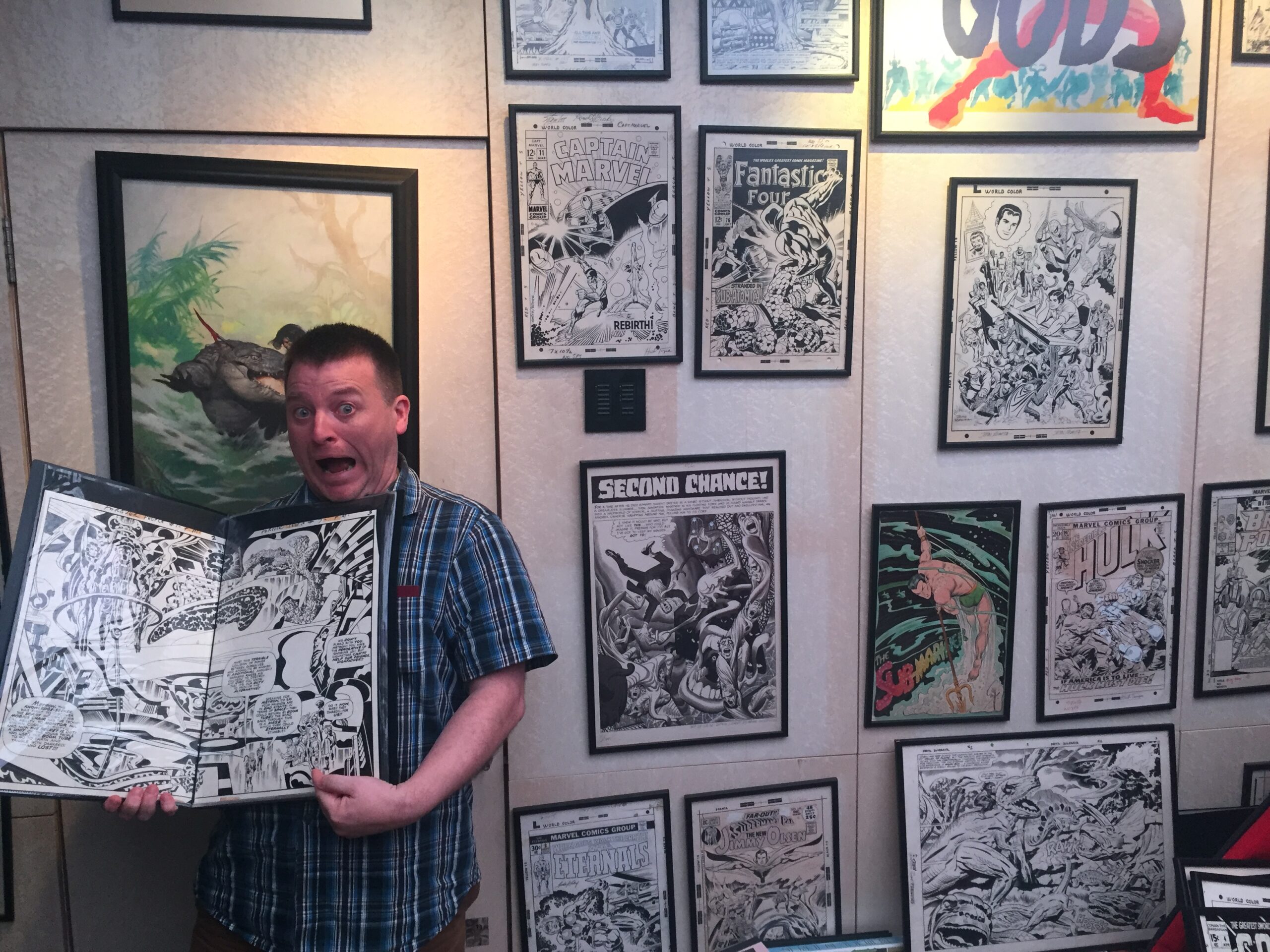
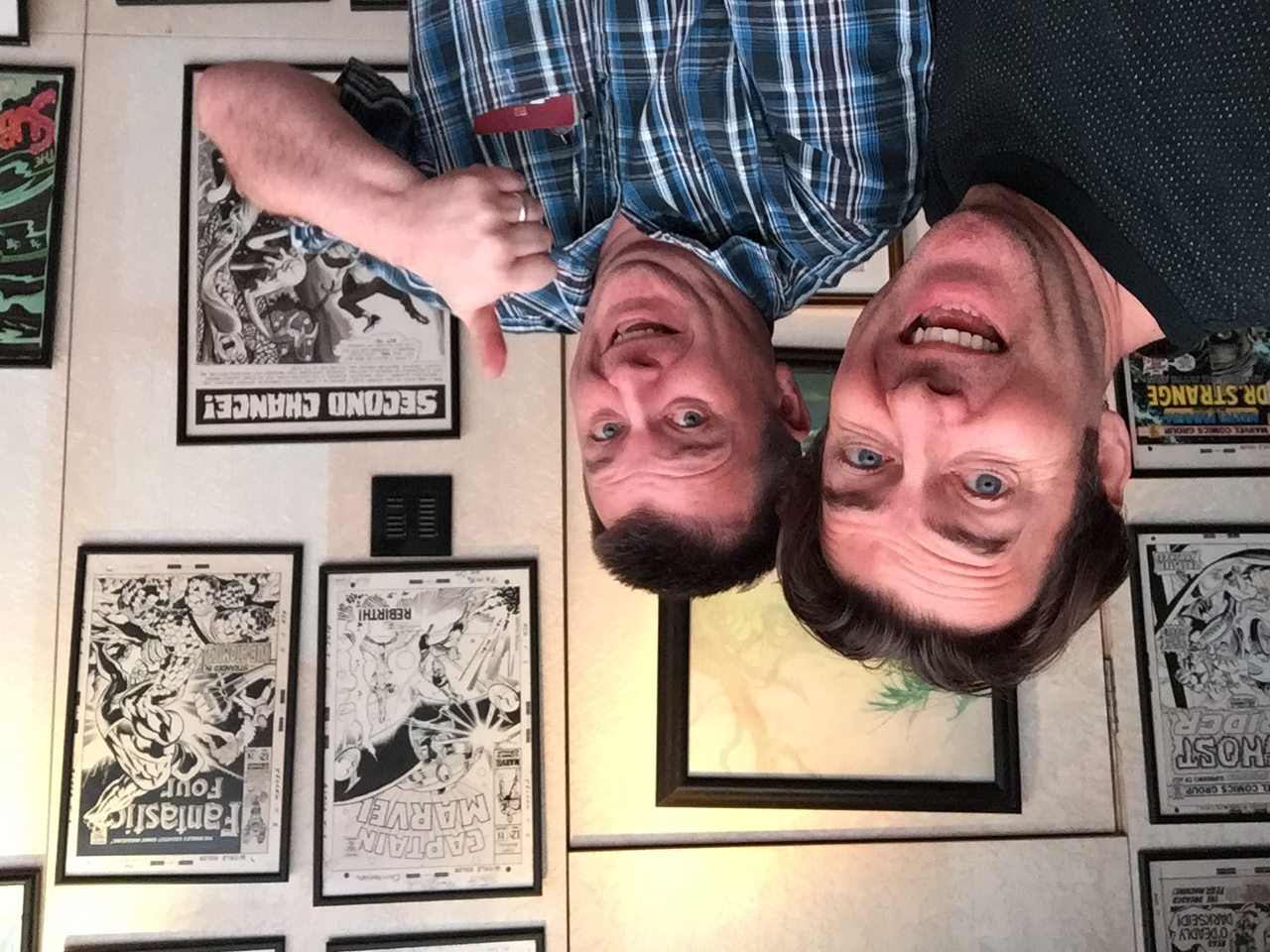
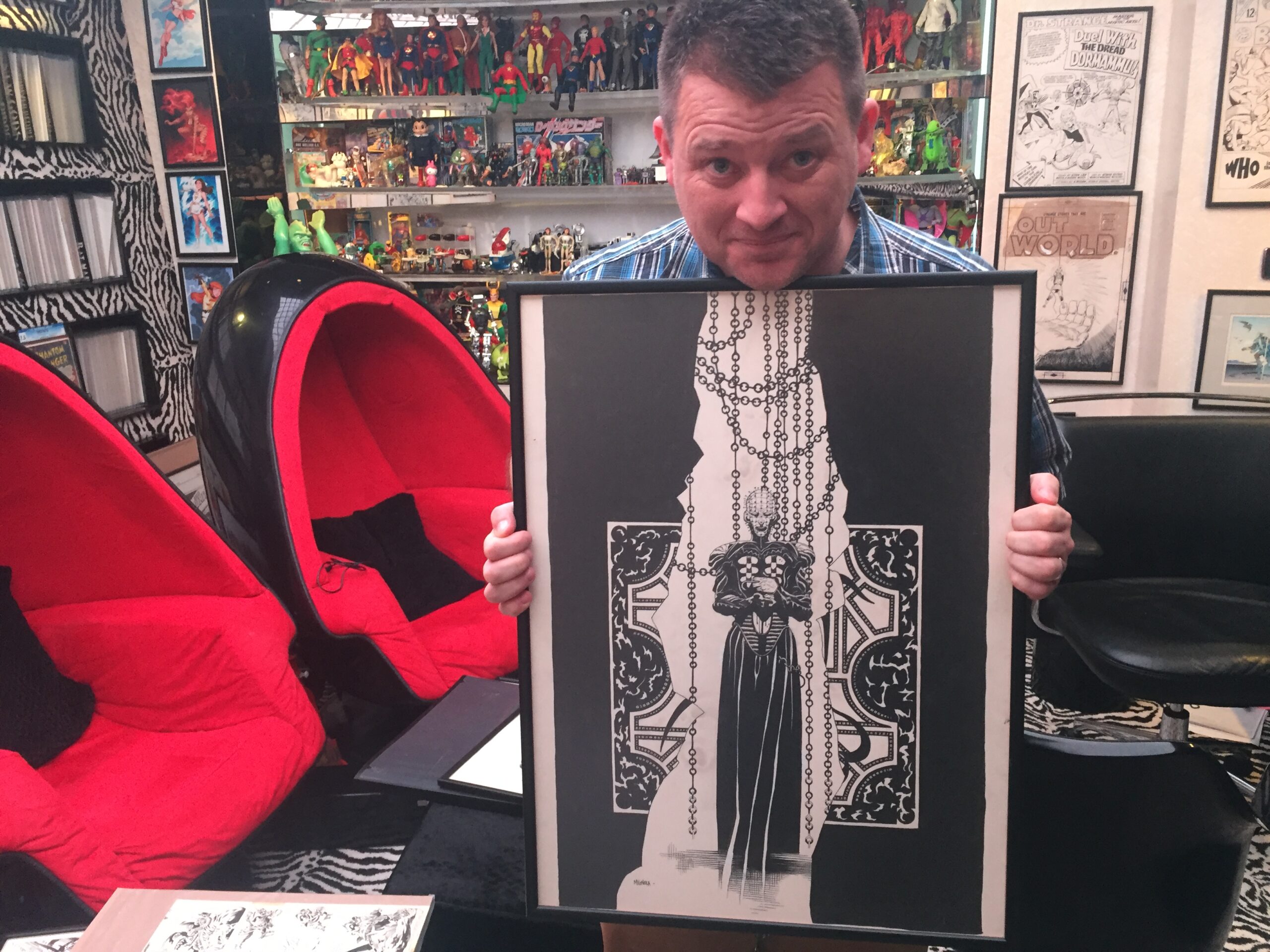
Captain Tomtom and Nathbot
Inktober. I thought I’d try something more ambitious than simply inked drawings and maybe take a stab at a kids comic. Something for my kids to enjoy (or at least my youngest). One day at a time. I might falter, I might not get through it, but at least I tried… right?
Creating Comics 2: Writing a script
Week 2 of my comic course was about taking your idea and turning it in to a script. While there’s a little bit about structure and theme, I’m very much tailoring the course around writing for comics, and so we talked about writing for the four page format.
Making sure your artist has all of the things in the story that are essential for them to understand what they’re drawing (don’t hide stuff from the artist thinking “Oh this will be a cool twist for them”) tell the artist up front so they can be prepared for it.
You’ll want to have at least one establishing shot per scene, even one per page – The reader will only understand where they are in the story if you show them through the art or let them know via captions/dialogue. And you really want them captions/dialogue to be supplemental to the art.
Try not to dictate to the artist the shots to use,often they’re judging shots while looking for balance on the whole page. That said, there are a variety of shots that are common and you’ll know what beats you want your story to hit.
If you’re going to start a scene in a location let the artist know all the relevant information – time of day, what does the place look like.
Ideally this information turns up in the first panel of the new scene – regardless of whether the artist is expected to draw it all. So, if we open on the close up of a characters face, before we reveal the character is in a jungle during the day, as this information can help determine cast shadows/other things that might effect the art.
A good rule of thumb on a script is one page of script per page of art. (Unless you’re Alan Moore, in which case you get a pass).
John Wagner (Judge Dredd co-creator) scripts are often described as “really exciting telegrams” aim for that.
If you find your page is minimal description but dialogue/captions are bursting out over two pages then maybe… maybe… you’ve too much dialogue/captions.
(No hard and fast rules here, but Alan Moore’s 35 words per dialogue balloon is a good one)
Also keep in mind, some panel shots are more friendly to longer amounts of dialogue.
Extreme Close up can be hard to do while fitting in a LOT of dialogue.
Overhead shot wide angle can fit in a lot but can be very effective with a small amount.
Try to keep judgement on panel placement/size of panels up to your artist.
(Unless, for example, you expect to have a panel reveal be big, in which case simple writing “Big panel” is enough).
Remember the more panels you have the harder it is to do a BIG panel.
Reread the script – 7 panels? Lots of dialogue? Making a panel big automatically makes every panel around it smaller.
Best way to judge it is to get these things drawn up!
You really want to think of scene changes happening on new pages, or, if you can’t, think of good ways to transition (rather than “Meanwhile”). You want big reveal moments to happen on a page turn (which is hard to know when you’re unsure of the publisher and whether the pages will start on odd or even numbers)
(Dialogue that runs from one panel OVER a caption on a new scene panel can be especially effective)
Your artist will be trying to line characters so that the first one speaking is on the left (I’ll cover this in week 3 – layouts) but just keep that in mind, if you dictate the geography too much it makes their job more difficult and they may end up ignoring you!
We did a little q&a about pitching.
2000Ad are the only publisher open to blind submissions of comics – future shocks are the way in.
Image and various other publishers are open to complete submissions – writer/artist/letterer/colourist with a complete package, but this can be tough to do as payment is at the backend (so your artist can be working for several months before getting paid).
The Big Two are closed doors for blind script submissions. Really you get to pitch to these guys by invitation only. Get work published, get to conventions, build relationships and then ask if you can pitch.
Macbeth
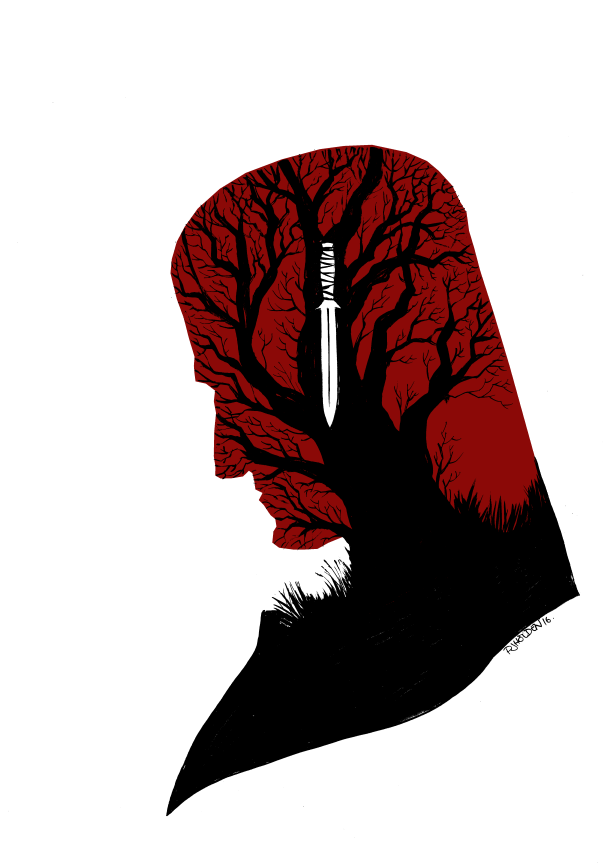
I started acting last year (after a 20 year absence) first play was macbeth. I drew this as a thank you for the director.
I’m VERY wary of becoming to go-to guy for my local am-dram group for posters/prints/etc. It’s a position I found myself in when I was doing student drama – ended up being the only unenjoyable part of it (people came to depend on you and so, when you turn away from it – because it was never a thing you were supposed to be doing – suddenly you’ve let them down).
I’ve ended up drawing a thing for the director for the new play I’m in (of course) but I really don’t want to mix the art and the acting (stupid isn’t it?)
The busier you are…
The more likely it is that people will offer you work you’ll then have to turn down.
Frustrating.
Dredd ep 5 finished
Phew. Just two days over deadline. Ugh.
Would’ve got it finished in time but for Monday in Dublin classes and rehearsals for a play on Sunday & Tuesday (and Thursday) that I’ve committed too.
I may have over committed.
The image above is a screen grab of pages 1-6 plus the thumbs that I’ve kept on file. Clip Studio Ex lets you deal with multi page documents and I’ve been working that way since I started with it – invaluable way to keep everything together.
Usually when I finish and episode I have a couple of days of nothing before starting the next thing. Not so here. My deadline for pencils on the first episode of this new Tanks thing is closer than I realised, so straight into WWII I go.
One episode of Dredd to go still too, but then that’s done that’s off my plate. Hurrah! (I love getting work, I love finishing work. It’s the working bit that’s hard).
Review of the Year 2015
I do one of these every year around new years day, this was from 2015. Unfortunately after shutting down my old blog the 10 years worth of these all disappeared. But here’s one that I have…

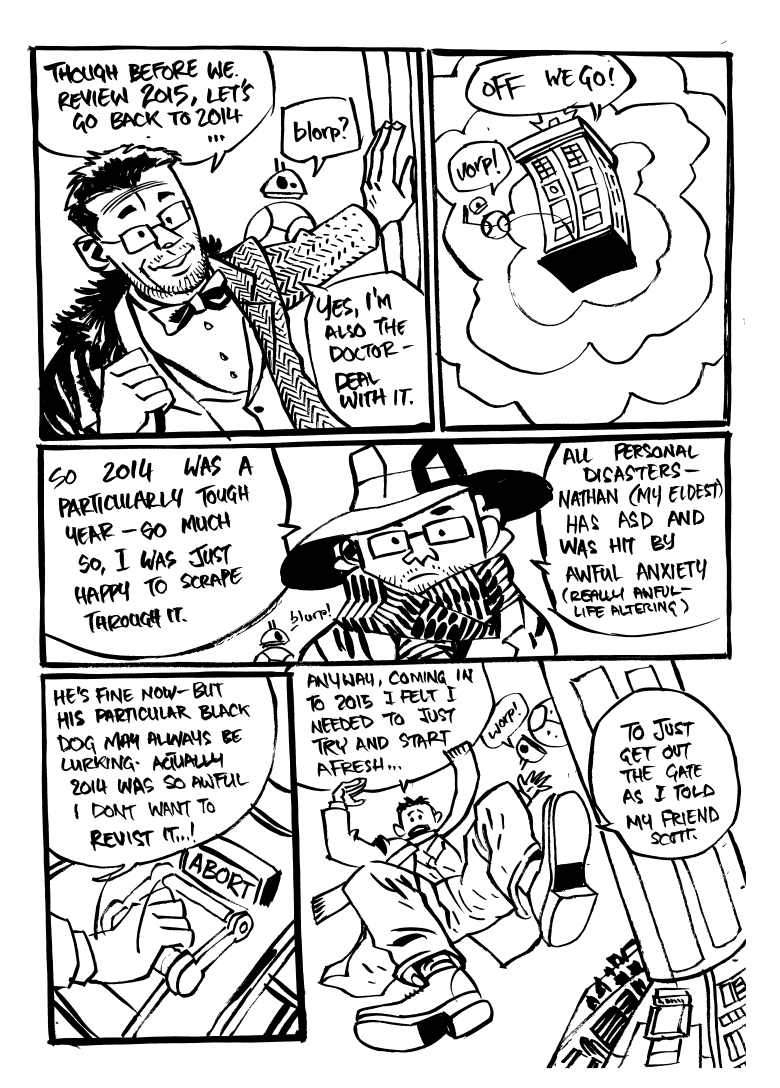
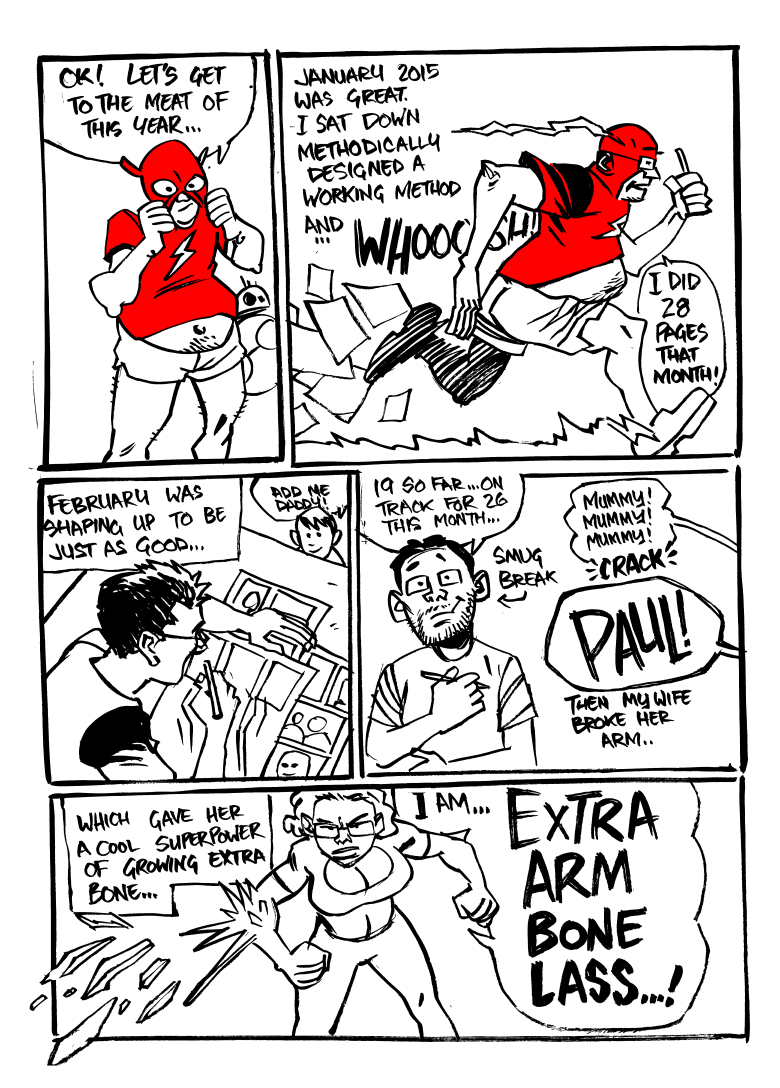
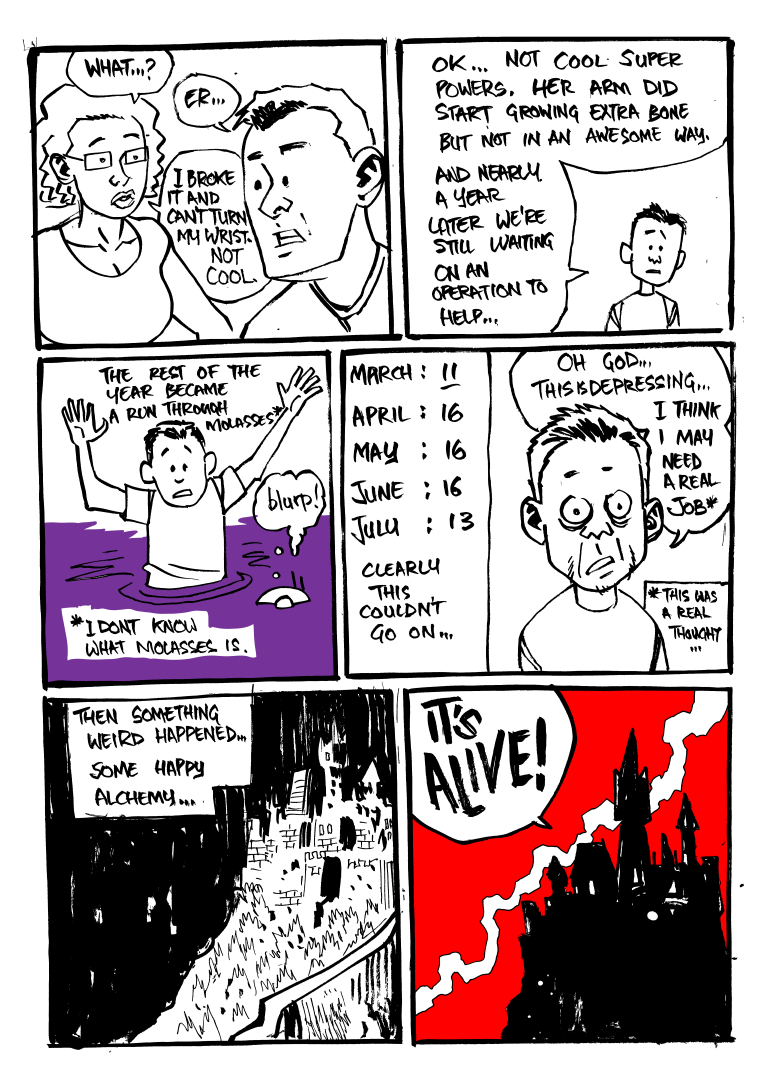

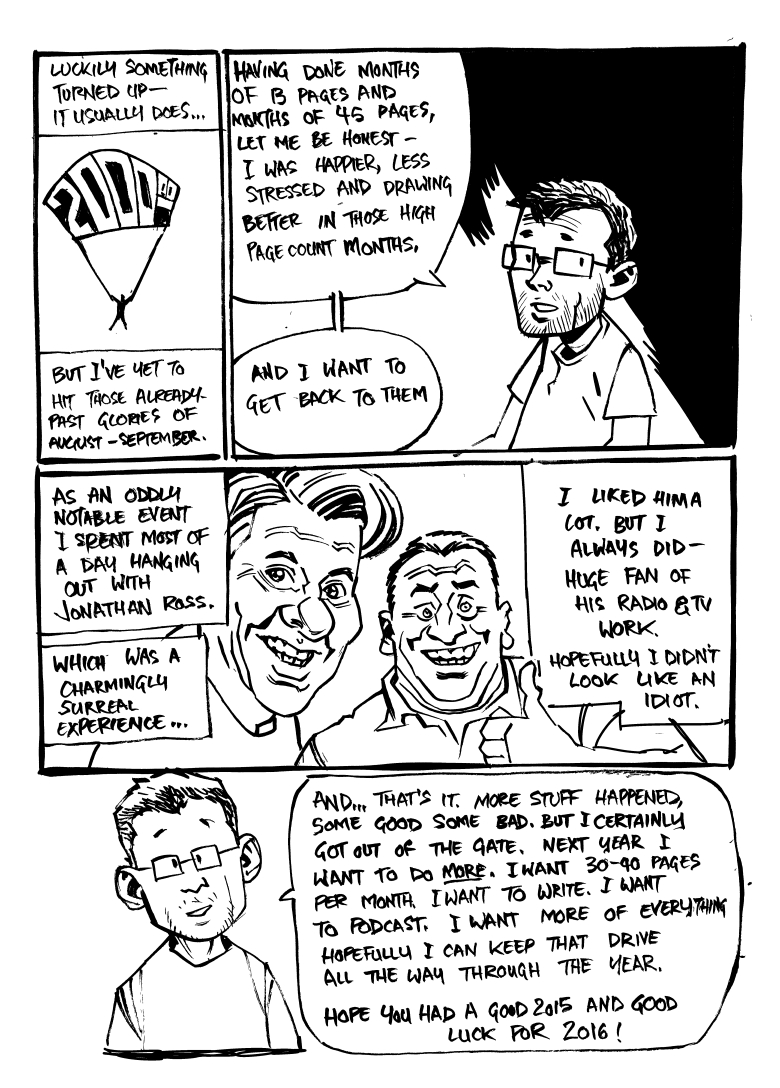
And here’s a brief follow up: Annette finally had an arm operation a couple of months ago (so, pretty much two years later). The extra bone growth had stopped her being able to twist her wrist and was starting to cause a numbness (not good!) and arm operated on, she has a large (but cool) scar on her arm, and is largely doing fine.
My productivity was up and down for the rest of the year, and actually 2016 turned out ok. 2017 started slow but hopefully will be good…
Drawing tanks
From an imagineFX Article
Numbercruncher interview from the archives
With me and Si Spurrier. I can’t remember where this ran, so forgive the uncredited nature of it. But it might be fun..
So the book has been described as “a time-twisting romantic thriller-noir metaphysical black comedy”. Can we expect a lot of dark humor?
SS: Heh, yeah, describing the book in genre terms has become something of a joke in itself. It doesn’t really sit terribly neatly in any single category… which is either a demonstration of how horribly inadequate genre terminology is, or a sign that PJ and I are contrary bastards who don’t like pigeonholes. To your description above I’d also add a hint of sci-fi and a glimmer of crime, but yeah… “time-twisty metaphysical rom-com thriller” covers most of the bases.
It’s basically the story of a man who breaks all the rules of existential reality in order to be reunited with the woman he loves… except told from the point of view of the violent thug sent by the Divine Authority to stop him.
Hence, yeah, a typically bleak humour suffuses the whole thing. I tend to think of comedy as a glue which bonds together all kinds of supposedly disparate ideas and moods, and as a secret weapon for reconciling important themes, heavy moments, explodo action, etc. There’s nothing more delightful than taking readers by surprise, and having a constant undercurrent of dark smirk-inducement allows you to do just that.
PJ: We’re both steeped in the 2000AD school of story telling, which is pretty much nothing but deep veins of rich black humour. Plus, I’m from Northern Ireland where there jokes are usually measured in how bleak they are.
Can you tell me anything about the Karmic Accountancy or the Divine Calculator – without going into spoiler territory, of course!
SS: The Karmic Accountancy is our cynical, abstract notion of what it’s like “behind the scenes” of the Universe. It’s part afterlife, part administration, part engine-room. It’s basically the place where all the colour and beauty and awe of life/reality/existence is reduced to a set of rules and regulation. And numbers in a book. And petty-minded arseholes in pinstripe suits endlessly stamping forms, passing round bits of paper, etc. It’s Brazil with added ontology. It’s what Heaven would look like if it turned out God was an anally-retentive ratlike accountant obsessed with neatness, precision and bureaucracy.
…which is precisely what he is, in this story. The Divine Calculator: a supreme being with a horrible laugh, big ears, halitosis and a cat called Mimpsy. I’ll let PJ wax lyrical about the visual inspiration for all these things, but… yeah: it’s all about juxtaposing all the good things in our story – love, life, happiness, devotion – with this soulless joyless abstraction of metaphysical shittiness.
PJ: Its always fun working from Si’s scripts – he’ll often throw in big abstract concepts that leave you scratching your head thinking “how the hell do I draw THAT”? But, visually, I think Si gave me enough cues to just sit down and draw. Oddly the real world was more of challenge. The afterlife, the Karmic Accountancy, was just super busy and lots of detail and very fun to draw. The real world, though. That was tough.
Every time I get a look at Bastard Zane, I see endless possibilities for storytelling. He looks like a guy that has a lot of stories in him! Will we learn anything about Zane, or is this really the Mathematician’s story?
SS: Ha. Both, weirdly. It is the Mathematician’s story – sort of – but the whole thing is told from Zane’s point of view. We get to know a little bit about the guy at the start, but broadly speaking he’s a cipher: a relentless brute whose motives for preventing the Mathematician’s romantic quest are at least as strong as the romance itself. That said, by the end of the book we’ve realised Zane has some unexpectedly deep waters – not that that will stop him from pursuing his mission.
The whole thing is kind of an exercise in screwing about with expectation and conventions. And Zane’s just so brutishly likeable – it was impossible not to tell the story through his eyes.
This was originally a black and white work. Did you find any challenges when you decided to make the work color? Do you feel like it changes the noir feel of the book at all, or did the noir feel of the original art inform your color choices?
SS: I’ll let PJ field that one, except to say that we always had it in mind that the art would eventually be coloured – or at least, partially coloured along cunning Powell-and-Pressburger lines…
PJ: As Si said, we started wanting it coloured, but time and resources were the enemy. So, in the end I went with a greywash afterlife and a very stark black and white real world (reasoning if we managed to procure the services of a top notch colourist, having the coloured artwork in pure b&w will be the best thing. And now we have the wonderful Jordie Bellaire on board for colours I’m more than happy!)
Is Numbercruncher influenced by your own reading tastes? Do you enjoy noir and black comedy?
SS: Yeah, I suppose it is – though not directly. My tastes tend towards the unlikely, the ungainly and the unconventional: mashups of genres and ideas which shouldn’t be comfortable bedfellows but somehow manage to be just that. I like speculative fiction in which the big world-building stuff is incidental to a smaller, more human story. I like the Bladerunners and the Brazils of the world. I like stories where the Big Idea (“the afterlife is a gigantic accountancy!”) is just the starting point from which all subsequent insanity spills.
It’s weird to say this, because I’m not a huge fan of the Sin City books (they’re gorgeous to look at – don’t get me wrong) but it’s a no-brainer that Bastard Zane is a spiritual cousin of Marv. There’s something so wonderfully appealing about these big unstoppable diamond-in-the-rough slabs of meat characters. I wondered how far we could push the “loveable bastard” trope before the “loveable” bit became unsustainable. Zane’s job in this story is – basically – to prevent the happy ending. And yet, reading back through it, I’m pretty pleased about how easy it is to root for the guy.
PJ: Artwise, it was less influence from reading and more influence from movies. The Powell-Pressburger “A Matter of Life and Death” especially (though there are plenty of other B&W or colour movies dealing with the after life). Though, they were less a direct influence and much more me pulling memories of those films out of my childhood.
What types of comics and books are you reading and enjoying artwork for?
SS: I’m pretty bad at keeping up with monthlies these days (though I’m loving David Hine and Doug Braithwaite’s Storm Dogs, and I can’t believe you – yes you, reading this right now – aren’t picking it up). So most of what I read is in collected form, which gives me the slightly dubious privilege of ignoring fads and picking from ACROSS TIME’S MIGHTY SPAN. For instance, I only just got around to Brian Wood’s Northlanders, which is splendid. Alan Moore’s Neonomicon from Avatar is a characteristically intelligent retooling and – I suspect – affectionate ribbing of (the overrated) Lovecraftian mythos. Oh, and I only just discovered Joe Sacco. Joe Sacco! Safe Area Gorazde might be one of the best things I’ve ever read.
PJ: 2000AD, always, always 2000AD. I’m looking forward to seeing Stephen Mooney’s Half Past Danger, and Pat Mills and Kev O’Niell’s Marshall Law Omnibus has just arrived in my house and will probably sustain me for comics over the summer.
I see that Numbercruncher is currently scheduled to be a 3-book series. Do you see yourselves continuing the run if it receives positive feedback?
SS: It’s a four-part run, actually – I think there was a minor FUBAR in early solicits. But, well – we’ll see. The first series is a remarkably twisty beast which (I tend to think) rather presupposes that it has a definite ending. Buuuut there are a few threads left dangling, and I suppose there are still a couple of genre conventions PJ and I haven’t kicked in the balls yet, so never say never.
PJ: I think we run a pretty tight ship on this series – and things are very cleanly wrapped up, so I doubt there’d be room for a sequel, but, you know, Zane was working in the Karmic Accountancy for a long, long time. So who knows..
